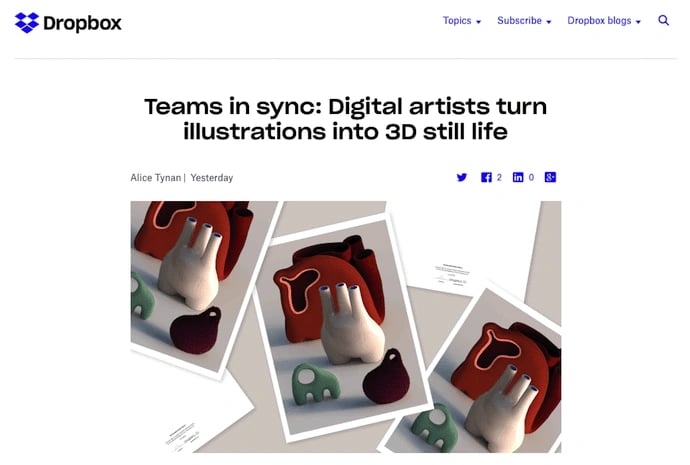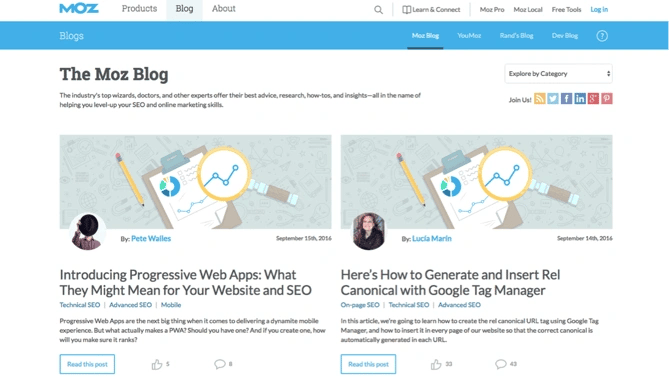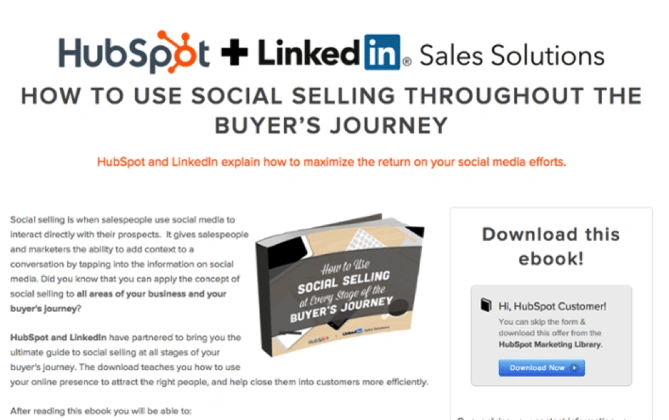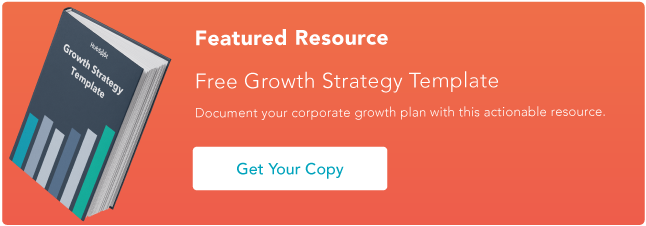Clients often prefer being able to make smaller, monthly payments, while investors like businesses that generate predictable recurring revenue, which makes it easier to forecast and understand the business' health.
And when it comes to business health, growth is critical to success. That's why we've put together a roundup of strategies SaaS businesses can use to ramp up their lead generation efforts. Need inspiration for your own strategy? Check out the ideas below.
SaaS Marketing Strategies
1. Content Marketing
Businesses around the globe are using content marketing to build their brand, attract visitors to their website, and generate leads. A key advantage of content marketing is that it has a compounding power of return -- just like a smart investment, it increases in value over time.
Importantly, content continues to drive leads, whereas other forms of marketing, like pay-per-click (PPC) advertising, will only do so for as long as you continue spending. It's for this reason we think of content as an asset that businesses own, whereas online advertising is rented. This distinction is important for SaaS marketers to consider.
Looking for content marketing inspiration? Here are three SaaS businesses that use content to generate leads:
Dropbox
The file sharing and storage service has many types of potential customers and attracts them with targeted content at the Dropbox, Dropbox Business, Dropbox Tech, and Dropbox Developer blogs. They also host a number of webinars to communicate their credentials to prospective clients.

Intercom
Intercom's content marketing strategy focuses on product management, design, startups, and marketing. The customer communication platform is fast becoming known for the quality of the Inside Intercom blog, podcast, and books, all of which help build their brand and drive qualified leads.

Moz
Moz has developed a reputation for its thought leadership content. They publish a blog post each day, as well as create authoritative guides, and of course, release their Whiteboard Friday videos -- all of which generate leads.

While content should be a key part of your strategy it's important not to overlook content distribution. In short, it's no use investing in content creation if you neglect distribution. Want to learn more? Check out this post by HubSpot's VP of Marketing, Kieran Flanagan, on why you should spend 50% of your time on distribution.
2. Product Trials
The product trial is fast becoming an important source of lead generation for the SaaS industry. Nothing beats “test driving” a product and your business should consider making a trial available via your website if you don't already.
Trials are a particularly effective lead generation tool if you're selling to a tech-savvy audience that want to experience the product, rather than speak with a sales rep. Product trials are typically self-serve, so you can continue to generate leads with little ongoing marketing investment.
However, it's important to mention a few guardrails. You need to ensure people have a positive experience when trialing your product, so you should consider providing some onboarding or support, depending on the complexity of your product and your unit economics. This could be either through one-to-one calls, group webinars, automated emails, or a combination of all three.
The value of product trials is that they are a strong indicator of buyer intent. A prospect is investing their time getting to get to know your product. At HubSpot, we know that people running a trial have a higher propensity to buy -- we call these folks product qualified leads (PQLs) and we track them very carefully.
The key is to strike a balance between demonstrating value without overwhelming the prospect and doing it in a light-touch and cost effective way. This requires some trial (pun intended) and error, but with ongoing optimization, product trials can become a stream of highly qualified leads.
3. Search Engine Optimization (SEO)
SEO works hand in glove with content marketing by making your content discoverable on search engines like Google, Bing, and Baidu. You should think of SEO in two separate yet complementary categories: on-page SEO and off-page SEO.
On-Page SEO
The good news about on-page SEO is that it's entirely within your control. You need to create content that people want to read, link to, and share, but there are also other factors to consider.
These include keyword strategy, internal linking, use of titles and descriptions, as well as page load time and UI. For a detailed look at what makes a well optimized website, check out this on-page SEO guide.
Off-Page SEO
People frequently think off-page SEO refers solely to link building, but there's more to it than that. While links are important, it's the quality of those links that matters. High-quality links from trusted and authoritative sites trumps quantity every time. Social media is also important, as shares and links from influential social accounts are another quality indicator.
The best way to gain links and shares is by creating a distribution strategy. HubSpot's Director of Acquisition, Matthew Barby, gave a talk at SearchLeeds called ' There's more to life than "great content" ' which explores this in more detail.
4. Referral Marketing
There's a growing body of research that shows referrals are one of the most effective types of leads. Although referrals are typically low cost and close relatively quickly, there's a referrals mismatch among sales and marketing, with 56% of sales reps calling referrals "very important" yet only one-third of businesses having a program in place.
There's a lot of debate on whether or not companies should incentivize referrals. One school of thought is that you won't generate many referrals without an incentive, while the opposing view is that if you incentivize too heavily, you may get low value quality referrals. The best advice is to test which works for your SaaS business and then optimize for that.
Before focusing on optimization, the most important part is launching your referral program. There's software available which can power your referral program from start to finish, but at minimum we suggest you create a landing page on your website where people can make referrals.
To ensure you get quality referrals, explain what makes a good referral. This could the person's job title, industry, or size of the company they would for. You should also clearly say if, how, and when people will get incentivized.
Marketing teams can make it easy for sales, customer success, and support teams to ask for referrals by drafting templates they can use. The most important part here is making it easy for sales reps to make the ask, and empowering them to do so.
5. Google AdWords
While inbound marketing can greatly reduce your AdWords spend, millions of people still click on search engine ads each day. If you don't want to miss out on a portion of potential leads you should still continue to invest in PPC, especially with ads becoming more prominent in Google search results.
PPC remains popular for several reasons. It delivers targeted traffic to your website and is highly scalable, meaning you can increase or reduce spend based on the needs of the business on any given day. It also has a lot of inherent predictability -- both in terms of cost and results -- which appeals to CFOs or those that have traditionally controlled marketing budget.
The best advice is to run a series of tests and see what activity generates the best ROI for your business. There's a great variation in competition between industries, but the fact remains you can generate significant levels of traffic and leads from PPC if you're willing to pay for it.
HubSpot has launched the Ads Add-On so our customers can run inbound and paid campaigns from within the software.
6. Co-marketing
Many SaaS businesses decide to collaborate by running a co-marketing campaign with other companies that either complement their product offering, or share a similar point of view or approach to business.
There's no hard and fast rule about co-marketing, but typically the companies involved create a piece of content, such as an ebook, host a webinar, or publish some research. The leads generated and the costs incurred are also shared by the companies participating.
Both companies have the opportunity to leverage each other's following, and potentially reach a different audience. If both teams are aligned, co-marketing can be very effective. However, it's important to ensure both teams are in agreement and understand expectations from the start.
By joining forces with other prominent companies, you can create a highly desirable piece of content and generate leads. Co-marketing, when executed effectively, is a cost-effective approach to generate leads, increase the reach of your brand, and demonstrate thought leadership. HubSpot frequently partners with other companies in co-marketing campaigns, such as this example of HubSpot and LinkedIn:

7. Retargeting
Regardless of whether your key conversion metric is an ebook download, online purchase, or free trial, the fact remains that most website visitors never take the action you want them to. Using retargeting (also known as remarketing) you can dramatically increase conversions by re-engaging people that left your website.
Retargeting tracks your website visitors and then displays online adverts as they visit other sites around the web. Many ecommerce sites lead the way with retargeting by offering contextual offers to lure back website visitors. Just think of the time you were looking at an item of clothing online, left the website, and then saw adverts (often with a discount) promoting that pair of jeans on your favorite websites or social media. That's retargeting in action.
Regardless of the industry, you can (and should) use retargeting to turn hard earned website visitors into customers. And most retargeting software now enables marketers to target people beyond website visits. For example, you can launch a campaign based on events -- such as opening an email or attending a webinar -- while some tools let marketers target people with similar characteristics that haven't visited your website yet.
Retargeting is a valuable tool for marketers as it gives your brand another chance to establish trust, credibility, and familiarity with website visitors. (HubSpot customers: You can leverage retargeting within the HubSpot Marketing Platform by using the AdRoll integration.)
These are tried and tested SaaS marketing strategies to help software companies grow, but as always, we recommend you test, analyze, and optimize them to see what drives the best results for your business.
SaaS
.png?width=112&height=112&name=Image%20Hackathon%20%E2%80%93%20Vertical%20(56).png)




-Aug-26-2022-07-52-29-78-PM.png)



